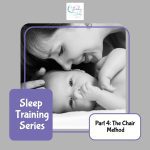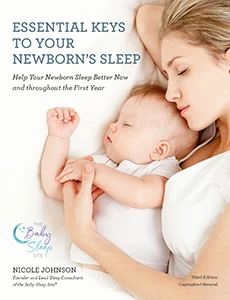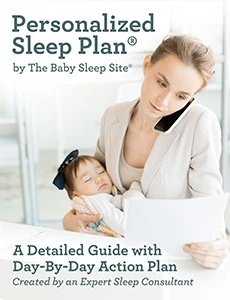 Cry It Out is a sleep training method that gives babies space to learn how to sleep in longer stretches at night and take longer naps. Cry It Out is also called Extinction or Controlled Crying. There are a variety of ways to implement it. Is cry it out right for you? If so, at what age should you try it? In this post, you will learn more about this method, what age to consider trying it, and how to do it safely.
Cry It Out is a sleep training method that gives babies space to learn how to sleep in longer stretches at night and take longer naps. Cry It Out is also called Extinction or Controlled Crying. There are a variety of ways to implement it. Is cry it out right for you? If so, at what age should you try it? In this post, you will learn more about this method, what age to consider trying it, and how to do it safely.
Cry It Out Defined
First, let me define what I mean by “Cry It Out” because, in my 15+ years as a sleep consultant, I’ve learned that it means different things to different people.
What Cry It Out Isn’t
- Cry It Out is NOT a replacement for feeding when baby is at an age they cannot comfortably sleep all night without food.
- Cry It Out is NOT meant to be used when baby is hungry, wet, very sick, in pain, etc.
- Cry It Out DOES NOT mean putting your baby into a room, closing the door, and ignoring baby forever and ever.
- Cry It Out is NOT a replacement for parenting when baby truly needs it at any age.
What Cry It Out IS
- Cry It Out is a sleep training method to break unwanted sleep associations.
- Cry It Out is setting limits on what you will and won’t allow your baby to do (at nap time, all night, etc.).
- Cry It Out is giving your baby space to allow them to learn a new skill.
- Cry It Out helps your baby learn how to put sleep cycles together. We all wake between sleep cycles. The goal is for your baby to learn to put them together themself.
That’s it! Sometimes it’s just about setting limits. This can mean that you will not nurse all night or replace a pacifier 10 times per night at a certain age or rock your baby in the rocking chair for 3 hours and then every 2 hours after that (like my son wanted me to do). Those are all sleep associations that sometimes need to be fixed (and not replaced with a new one).
The act of crying does nothing to teach your baby to sleep and it won’t change their personality. Cry “it” out is simply letting baby find their own way to fall asleep and allowing them to cry out frustrations about not being able to get put to sleep in the way they’ve become accustomed to. None of us get better at something without practice.
OF COURSE, some parents can nurse all night and it works great for them. Others can rock their baby for 10 minutes and their baby sleeps all night. But, many of us are simply NOT that lucky. If the baby cried being in the car seat, would you take them out while driving because they were crying?
It is hard for many of us to break habits. The longer you’ve had it, the harder the habit is to break, right? But, at what age can you try it?
You May Also Be Interested In
- 11 Cry It Out Do’s and Don’ts
- 5 Things to Do Before Sleep Training
- 5 Ways To Help Your Child Sleep Through the Night (FREE e-Book)
Cry It Out Age For Babies and Toddlers
So, what’s the right age to allow a baby to cry it out? Once again, this answer will vary. I try to empower parents here on this site. You know your baby best! The average age for Cry It Out is 4 to 6 months old or older. Let’s explore further.
At some point, you know that your baby is capable of putting themself to sleep. But, your baby prefers you to rock, bounce, breastfeed, give them a bottle, etc. them to sleep. There is not going to be a magic age. One day you will realize what baby once NEEDED to fall asleep, now they simply WANT. That is the key to finding the “right” time. Another key? You are simply too exhausted to go on like this and just can’t do “it” anymore.
Having said all that, if your baby’s temperament is “easy”, sometimes all it takes is for you to just get out of the way a little bit and allow your baby to fuss for 5 minutes or less. And, you can do that at any age even as young as 2 to 3 months of age.
The ideal age for formal sleep training such as Cry It Out is usually before your baby can sit up and/or stand. These tend to complicate things, but we work with babies and toddlers at a variety of ages up through 4-6 years old. It’s never too late to establish healthy sleep habits!
Cry It Out Age: Minimum to Try
If you are going to use Cry It Out, I recommend your baby is at least 4 to 6 months old and when it’s time to stop swaddling. You do NOT, however, have to night-wean at the same time. There are right and wrong ways to do Cry It Out.
Cry It Out: Newborns and Toddlers
If your baby is younger, we outline newborn-friendly sleep coaching strategies, including sample sleep-inducing routines, in our e-book, Essential Keys To Your Newborn’s Sleep. In addition, we offer special newborn-focused Personalized Sleep Plans®. These are tailored to guide your newborn to better sleep in a super gentle, age-appropriate, and safe way.
If you have a toddler, while Cry It Out is possible, there are some toddler sleep training strategies that can work a bit better.
You May Also Be Interested In
- Night Feedings By Age
- 3 Signs It’s Time to Night Wean
- Breastfeeding and Sleep Training – Can They Go Together?
- How to Handle Sleep Training Criticism
Cry It Out: How To
There are NUMEROUS variations to the Cry It Out Method. Here’s the most common way to do it and how we recommend if you are implementing Extinction:
- Do your Bedtime Routine.
- Establish a distinct end to your routine (a keyphrase, specific song or prayer, etc.)
- Put your baby down in their crib.
- Leave the room.
- Listen intently on the monitor until your baby goes to sleep.
- Sleep!
If you are doing this at nap time, set a time limit (e.g. 60 minutes). Then take a break. If you are doing this at bedtime, there usually isn’t a limit. But this is YOUR baby and we highly recommend you personalize the experience. That’s why we make Personalized Sleep Plans for families every single day. In our opinion, there is no one-size-fits-all approach for unique babies.
How Much Crying Is Too Much Crying?
On average, most families with which we work who do Cry It Out have babies who cry 30-45 minutes in one stretch. However, it’s not uncommon for some babies to cry 1-2 hours during the height of sleep training. In some cases, babies become hoarse from crying. When Cry It Out works and is the right strategy for the baby, most people will be “done” within 3 to 7 days with the longest crying periods the first 3 to 4 nights. Keep in mind that your baby’s age and baby’s temperament will be big influences on how any sleep training will go no matter what method you use!
Cry It Out Age: Tips and Considerations
Here are a few tips and considerations as you embark on this journey to better sleep:
- Get Your Doctor’s Clearance – You should ensure your baby does not have any health problems by visiting her pediatrician before starting any formal sleep training method such as Cry-It-Out. If your baby changes sleep patterns abruptly, it can be an ear infection or reflux, or another issue. These should be ruled out, first. Generally, if your baby has had “sleep problems” for several weeks/months and there has not been any health issues, that is when you may want to consider the Cry-It-Out Method. As long as your baby is healthy, sleep training is safe.
- Make A PLAN to follow – Knowing how you will approach the sleep training process ahead of time can help you feel confident. Most importantly, a plan will help you remain consistent. Consistency is key! Will you work on nights, naps, or both? How will you handle it if your baby has been crying for “too long?” Parents who send confusing messages to their babies tend to see crying increase rather than decrease.
- Unswaddle Your Baby – I never recommend allowing a baby to Cry It Out when they are still swaddled because babies need to find a way to self-soothe by finding their fingers/thumb. Always unswaddle first!
- Check Your Child’s Schedule – There’s no worse feeling than letting your baby cry and realize you were trying naps or bedtime at the wrong time. No amount of crying will fix something else that’s wrong! Be sure to put your baby on an age-appropriate sleep and feeding schedule.
- Rule Out Other Reasons for Waking – There are many reasons a baby wakes up at night. Be sure to rule them out before you start sleep training. Here are 15 Reasons Why Babies Wake at Night to help you out.
- Consider Checks – Extinction and Cry It Out typically means you leave the room and let your baby cry until they fall asleep. When your baby cries for 10 minutes, this is much easier to do. If your baby is more persistent or spirited, you might want to consider The Ferber Method (aka Controlled Crying). Here you’ll go in to check on your baby.
- Consider Staying in the Room – The traditional method of Cry It Out is to leave the room. This can be challenging during a height of separation anxiety, for example. The Chair Method can be a nice alternative for babies going through a sleep regression or peak of separation anxiety.
You May Also Be Interested In
- 5 Common Baby Sleep Training Methods Explained
- Ferber vs. Weissbluth?
- Warning: Babywise May Not Be Right For Your Baby
- 10 Cautions About 12 Hours’ Sleep by 12 Weeks Old
- Extinction Bursts and Your Baby’s Sleep








